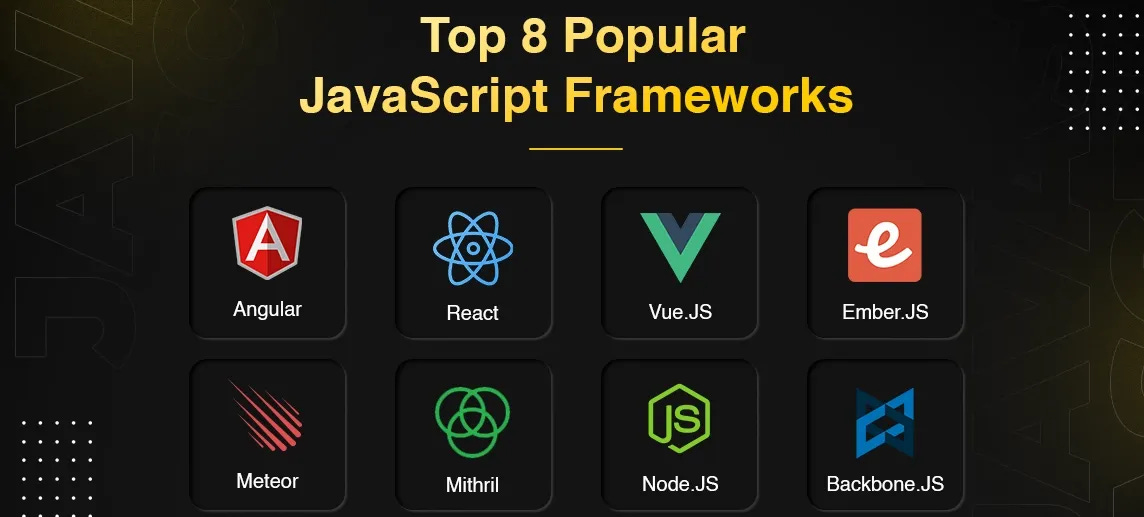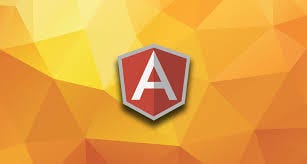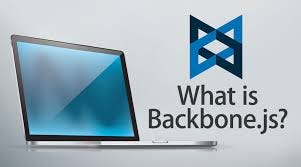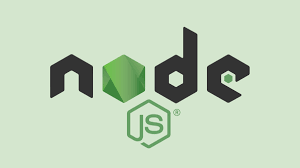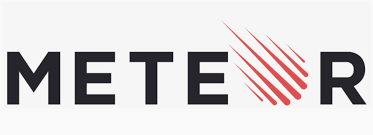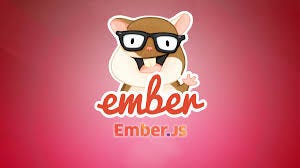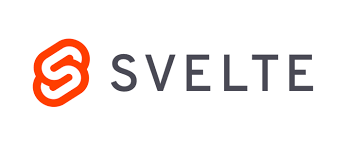What are Frameworks?
Frameworks are pre-written templates or tools that offer ready-made components to accelerate the production and development process. They provide a foundation upon which developers can build, making the development of applications faster and more efficient.
What are JavaScript Frameworks?
JavaScript frameworks are collections of pre-written JavaScript code that offer a structured foundation for building web applications. These frameworks simplify the development process by providing ready-to-use components, syntax, utilities, and design patterns. This allows developers to create complex web applications more efficiently and with less code.
8 MOSTLY USED JAVASCRIPT FRAMEWORKS>
1.REACTJS
React is a popular JavaScript framework primarily used by frontend developers to build client-side user interfaces (UI). It allows developers to create complex UIs by composing them from small, isolated pieces of code called "components." These components enable developers to organize their code into manageable sections, making it easier to maintain and scale.
One of the standout features of React is its ability to pass "props" (short for properties) between components. Props allow you to reuse components across different parts of your application without needing to rewrite or duplicate code, significantly enhancing efficiency and code cleanliness.
In addition to its core functionality, React projects often rely on external libraries or dependencies to extend their capabilities and improve performance. These dependencies are essential for a React project to function properly and include tools like REACT ROUTER for navigation, AXIOS for making HTTP requests, and REACT SLICK for implementing carousels, among others. These libraries streamline the development process and help your React projects run smoothly.
To know more about REACT visit the official website at: REACT.DEV
2. ANGULARJS
AngularJS is a JavaScript-based open-source front-end framework that was developed by Google and released in 2010. It is primarily used for building dynamic single-page applications (SPAs), where the content is updated dynamically without requiring a full page reload. AngularJS extends HTML with additional features, making it more suitable for dynamic web applications.
Limitations and Transition to Angular
Performance Issues: For larger applications, AngularJS can become slower due to its two-way data binding and digest cycle.
Complexity: The framework can be complex to learn for beginners, especially when dealing with advanced features.
Due to these limitations, Google introduced Angular (often referred to as Angular 2+), a complete rewrite of AngularJS, in 2016. Angular is a more modern, efficient, and scalable framework, which addressed many of the limitations of AngularJS.
Despite the shift to Angular, AngularJS is still used in many legacy applications, though it is no longer actively maintained as Google officially ended support for AngularJS in December 2021.
3. VUE JS
Vue.js is a progressive JavaScript framework used for building user interfaces (UIs) and single-page applications (SPAs). It was created by Evan You and was first released in 2014. Vue.js is known for being easy to integrate into projects and is particularly appreciated for its simplicity, flexibility, and lightweight nature.
Vue.js strikes a balance between the complexity of frameworks like Angular and the simplicity of libraries like React. It's particularly popular among developers who appreciate its gentle learning curve, elegant API, and powerful features. Whether you're building a small project or a large-scale application, Vue.js provides the tools and flexibility needed to create modern, performant web applications.
You can learn more about VUE JS here on:VUEJS.ORG
Backbone.js is a lightweight JavaScript framework that provides the structure needed for building complex web applications. It is designed to give developers a framework to organize code in a more modular and maintainable way, especially for single-page applications (SPAs).
Backbone.js is a powerful yet minimalistic framework that provides just enough structure for building robust web applications. Its simplicity and flexibility make it a great choice for developers who want to maintain control over their application’s architecture while still leveraging the benefits of a framework.
Want to learn more ? visit the official website at: BACKBONEJS.ORG
5. NODEJS
Node.js is an open-source, cross-platform JavaScript runtime environment that allows developers to execute JavaScript code on the server side. Traditionally, JavaScript was primarily used for client-side scripting, running in the browser. However, with Node.js, JavaScript can be used to build full-stack applications, including backend services, APIs, and more. Learn more at: NODEJS.ORG
Node.js revolutionized web development by enabling JavaScript to be used for server-side programming. Its event-driven, non-blocking architecture makes it highly efficient and suitable for building scalable, real-time applications. Whether you’re building a simple web server, a complex microservices architecture, or a real-time chat application, Node.js provides the tools and ecosystem needed to get the job done.
Meteor.js is a powerful, open-source full-stack JavaScript framework that enables developers to create web applications quickly and efficiently. This versatile tool combines both front-end and back-end capabilities, offering real-time data synchronization and seamless communication between the client and server.
Its ability to handle both front-end and back-end development makes it an excellent choice for startups and companies looking to build comprehensive web solutions quickly.
By leveraging Meteor.js, developers can streamline their workflow and create powerful, feature-rich web applications efficiently. Its unique combination of full-stack capabilities and real-time functionality makes it an attractive choice for many modern web development projects. Learn more here: METEOR.JS
7.EMBER.JS
Ember.js is a framework for building enterprising web applications. It emphasizes tradition over configuration, providing a structured architecture that promotes scalability and maintainability.
Ember’s two-way data binding and powerful templating engine contribute to a productive development experience. It’s suited for projects where a strong structure and opinionated guidelines are preferred.
Ember.js provides a solid foundation for building robust, scalable web applications, especially suitable for enterprise projects. Its structured approach, powerful features, and strong community support make it an excellent choice for teams looking to develop complex, maintainable applications efficiently. visit the website and learn more here: EMBER.JS
Svelte.js is a revolutionary approach to building user interfaces. Unlike traditional frameworks, Svelte shifts much of the work to compile time, which results in highly optimized and efficient code at runtime.
Its minimal runtime footprint makes it an excellent choice for performance-critical applications. Svelte’s simple syntax and focus on compile-time optimizations make it appealing for projects where bundle size and performance are top priorities.
Get to know more about Svelte here: SVELTE.DEV


